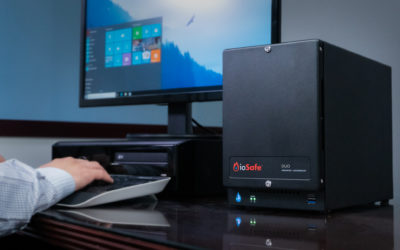ioSafe 1019+ NAS vs. 1517 NAS: What’s the Difference?
Lately, I’ve been asked quite often about the key differentiators between the legacy ioSafe 1517 NAS and the newer 1019+ NAS.
Throughout this review, I’ll delve deeper into their specific capabilities, why the 1019+ adds value to our client’s infrastructures, and how it helps them achieve their goals. Whether it’s data protection, resiliency, or promoting business continuity and Hybrid technologies, we aim to support safeguarding the key elements of a successful organization.
First and foremost, it’s a must to mention that the ioSafe NAS devices are based on the Synology Software DiskStation Manager (DSM). We typically follow Synology’s product releases to offer the latest capabilities of the software platform and DSM, along with enhancements to the hardware and usability in any IT environment. Today we’ll take a look at both the hardware and software capabilities.
If you’re familiar with ioSafe products, you’ll understand that the goal of our brand is to protect your critical data in the face of adverse natural or human environmental impacts. For businesses, we help protect your organization during disastrous events that could otherwise (and with other manufacturer’s products) destroy the critical data driving your company’s success, potentially damaging your business continuity to the point of lost revenue—or worst case—closing your business.
The 1019+ continues to hold data securely when exposed to fire reaching 1550°F for 30 minutes and completely submerged in 10ft of fresh or saltwater for 72hrs.
With those major factors in mind, let’s move on to some of the more impactful changes.
Hardware
While the 1517 integrated a CPU based on the Annapurna labs AI-314 with a 32-bit architecture, the 1019+ boasts an Intel based Celeron J3455 with a 64-bit architecture, providing more processing power and faster completion of tasks for our clients.
Put simply, the 64-bit processor can handle more data at once and accomplish your tasks faster while utilizing the standard and increased RAM available in the 1019+ (from the previous 2GB in the 1517 to 8GB in the 1019+).
The 1019+ also boasts a Hardware Transcoding engine. This can be beneficial if working with any organization that’s going to use the NAS as a multimedia server. Typically, these are hospitals, schools, or other locations where multiple people or groups might be trying to view stored media or streaming media at the same time. The 1517 didn’t have this capability.
General DSM Specifications
One of the most notable changes regarding the 1019+ is supporting the BtrFS file system architecture, which wasn’t available in the 1517.
Many times, a key component of your backup solution will include snapshots. A BtrFS file system is required for snapshot replication.
Along with the above-mentioned enhancement comes the SSD cache. The 1019+ supports M.2 NVMe read-write cache support, while the 1517 didn’t. The availability of SSD cache provides the ability to accelerate your system performance well beyond what was possible with the 1517.
iSCSI Storage & Virtualization
Newly added is the Virtual Machine Manager. Now you can deploy and run various virtual machines on the ioSafe 1019+, which wasn’t possible on the 1517 system. With virtual machines being very standard in a modern IT environment, this is a critical enhancement.
Data Protection & Backup Solutions
One of the central aspects of the ioSafe product family is to protect your critical data, which is why we’ve added these crucial features:
- The backup tools of the 1019+ now support a maximum of 32 tasks, when previously the 1517 only supported 2.
- Snapshot replication is now available due to the addition of the BtrFS file system support.
- Active Backup for G Suite, Office 365, and business are all additional critical enhancements.
For a side by side comparison, take a look at the table below. And keep an eye out for future publications, where we’ll delve deeper into discussing these capabilities and more with the ioSafe 1019+.
Hardware 1019+ |
Hardware 1517 |
||
| CPU | Intel Celeron J3455 64- bit x86 quad-core 1.5GHZ burst up to 2.3GHz | CPU | Annapurna Labs Al-314 32-bit quad-core 1.7 GHz |
| Hardware Transcoding Engine |
Supported codecs: H.264 (AVC, H.256 (HEVC), MPEG-2, VC-1 Maximum resolution: 4K (4096 x2160) Maximum frames per second (FPS): 30 |
Hardware Transcoding Engine | NO |
| Memory | 4GB DDR3L Non-ECC SO-DIMM X2 (provides 8GB memory capacity total) | Memory | 2GB DDR3L |
General DSM Specification 1019+ |
General DSM Specification 1517 |
||
| File System |
Internal: Brtfs, ext4 External: Btrfs, ext4, ext3, FAT, NTFS, HFS+, exFAT |
File System |
Internal: ext4 External: ext4, ext3, FAT, NTFS, HFS+, exFAT |
| SSD Cache | Read-write cache support, M.2 NVMe support | SSD Cache | NO |
iSCSI Storage & Virtualization 1019+ |
iSCSI Storage & Virtualization 1517 |
||
| Virtual Machine Manager | Deploy and run various virtual machines on ioSafe 1019+NAS, including Windows, Linux, or Virtual DSM | Virtual Machine Manager | NO |
Data Protection & Backup Solutions 1019+ |
Data Protection & Backup Solutions 1517 |
||
| Hyper Backup | Supports local backup, network backup, and data backup to public clouds | Hyper Backup | Supports local backup, network backup, and data backup to public clouds |
| Backup Tools | DSM configuration backup, macOS Time Machine support, Cloud Station Backup, Shared folder sync – maximum task number: 32 | Backup Tools | DSM configuration backup, macOS Time Machine support, Cloud Station Backup, Shared folder sync – maximum task number: 2 |
| Snapshot Replication |
Maximum of shared folder snapshots: 1024 Maximum of Replication: 32 Snapshot replication |
Snapshot Replication | NO |
| High Availability Manager | Reduce service downtime by setting up two identical NAS into one high-availability cluster | High Availability Manager | Reduce service downtime by setting up two identical NAS into one high-availability cluster |
| Active Backup for G Suite | Support G Suite, My Drive and Team Drive backup and restoration | Active Backup for G Suite | NO |
| Active Backup for Office 365 | Support Office 365 OneDrive for Business, mail, contacts, and calendar backup and restoration | Active Backup for Office 365 | NO |
| Active Backup for Business | All-in-one backup solution designed for heterogeneous business IT environment, enabling IT admins to remotely manage and monitor protection over PC, servers and VM on one centralized console | Active Backup for Business | NO |

Leif Watkins
Sales Director, ioSafe Global Sales
In June 2012, Leif joined ioSafe, and during his time he's played an essential role in development and support of the ioSafe vision and growth strategy, serving several critical roles including Customer Service Manager, Technical Support Manager, Sales Manager and now his current position as the ioSafe Global Sales Director. Leif is responsible for implementing programs and sales strategies that support CDSG Channel strategy.
Related Blog Posts
Off-Facebook Activity is Here: 3 Facebook Data Privacy Settings You Can Change Right Now
On Data Privacy Day 2020, Facebook launched a new privacy control tool for users called Off-Facebook Activity. Much like...
Power Outages are the New Normal in Our California Community
My small community—nestled in the foothills of Northern California—is one of 34 counties that experienced the first of...
Introducing the Fireproof and Waterproof ioSafe Duo
Today, we’re introducing the ioSafe Duo, a two-drive fireproof, waterproof storage device that is ideal for people who want...



